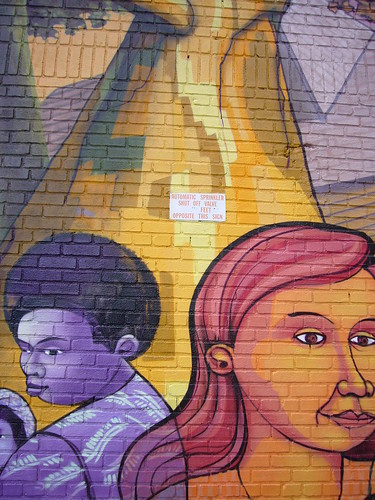from the Anthology Film Archives press release:
REPORT FROM THE GHOST CITY
video performance works by
The Disembodied Theater Corporation and Ars Subterranea
Monday, March 24, 7:30pm
With Ross Lipman & Julia Solis in person!
Anthology Film Archives presents an evening with The Disembodied Theater Corporation featuring dispatches, news, songs, and fragments from the Ghost City: the skeletal remains of abandoned towns, railways, and graveyards that stand as remnants of a lost society. Filmmaker Ross Lipman and author Julia Solis will present a haunting assemblage of ruins, rants, and shards of memory that paint a collective portrait of dystopia. The evening will feature two distinct presentations: NO WAY OUT BUT ONWARD, an adventure in psychogeography through New York’s High Line, and presentations by members of the arts group Ars Subterranea, DISPATCHES FROM THE WASTELAND: three short imaginary narratives set inside abandoned mental hospitals.
NO WAY OUT BUT ONWARD:
An adventure in psychogeography through New York's High Line
PowerPoint performance by The Disembodied Theater Corporation
Written and narrated by Ross Lipman
Suite for Bass, Viola, and Trombone by Laura Steenberge
Photos by Leigh Evans, Ross Lipman, Nina Mankin
The High Line is the abandoned elevated freight rail that runs through the west side of Manhattan. Soon to be the site of an aerial public park, it for the moment remains a haunted paradise above the city—a verdant wasteland inhabited only by occasional taggers, wanderers, and police. In October 2004 a ragtag group ventured up to explore. As they were to learn, it's a space with its own internal logic, interacting with its visitors in a way unique to each. NO WAY OUT BUT ONWARD is a recounting of that day's events, told in PowerPoint, the modern day equivalent of an old-time Magic Lantern performance.

Scene from No Way Out But Onward.
Presentations made by members of the arts group Ars Subterranea
DISPATCHES FROM THE WASTELAND:
Three short imaginary narratives set inside abandoned mental hospitals
Tales from the Sanatorium
Drawing inspiration from The Canterbury Tales, the graphic novel series depicts an imperious Nurse leading a band of disheveled souls through endless apocalyptic asylum landscapes, occasionally pausing to tell stories. In the first installment, the Nurse recounts her own tale, "Rubber Lullaby." A combination of derelict spaces with mixed-media collage and still photography created by Bryan Papciak in conjunction with Ars Subterranea, Tales from the Sanatorium is a graphic novel set in an abandoned mental hospital – staged like a movie, but photographed as a series of stills.

Scene from Tales from the Sanatorium.
Funeral Play
A surrealistic journey into a hospital bed, based on a forthcoming Furnace Press book by Julia Solis.
Irma
Excerpts from a postmortem diary by Tom Kirsch (http://www.opacity.us) and Julia Solis.
Followed by:
Met State
(Bryan Papciak, 10 minutes, color/b&w, 16mm, 2001)
An award-winning experimental short film by exploring the graphic nature of derelict space through an experimental study of an abandoned insane asylum.
About the presenting organizations and artists:
The Disembodied Theater Corporation is an amorphous performance entity devoted to the temporary manifestation of non-filmic cinemas.
Ross Lipman is an independent filmmaker, photographer, and writer who has presented work throughout the world at venues ranging from the Oberhausen International Film Festival to the Chinese Taipei Film Archive. His works have been collected by institutions and museums including the Sammlung Goetz in Munich. He is also one of the world’s leading authorities on the restoration of independent cinema, and was recently honored with the National Society of Film Critic’s 2007 Film Heritage award. In recent years he has been designing film, video, and performance works exploring urban decay as a marker of modern consciousness.
Ars Subterranea likes to play inside ruins and is comprised of artists, historians, and urban explorers working to create an intersection between art and architectural relics in the New York City area. Ars Subterranea’s aim is to instigate unique perceptions of New York's history by constructing narratives around the city's forgotten relics.
Julia Solis conducts archaeological parlor games and investigates ruined urban spaces. As the founder of Dark Passage, she started the creative preservation group Ars Subterranea in 2002 with the object of staging scavenger hunts and exhibitions in unusual locations in New York. She is the author of New York Underground: The Anatomy of a City (Routledge, 2004) and an editor of Furnace Press, which specializes in publications on urban decay.
Visit the project’s website: http://www.arssubterranea.org/sanatorium/ghostcity.htm
More about Ars Subterranea: http://www.arssubterranea.org
ANTHOLOGY FILM ARCHIVES
32 SECOND AVENUE NEW YORK, NY 10003; (212) 505-5181
About Anthology Film Archives: Founded in 1970, Anthology’s mission is to exhibit, preserve, collect documentation about, and promote public and scholarly understanding of independent, classic, and avant-garde cinema. Anthology screens more than 900 film and video programs per year, publishes books and catalogs annually, and has preserved more than 700 films to date.
Directions: Anthology is at 32 Second Ave. at 2nd St. Subway: F or V to 2nd Ave; 6 to Bleecker.
Tickets: $8 for adults, $6 for students & seniors; $5 for members.
















